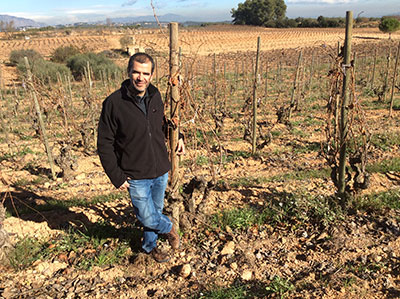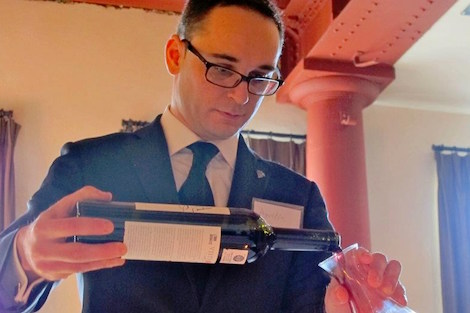
It is quite unusual to visit a Cava producer and spend the whole morning among vines, but as director Ton Mata sees it, “the vineyard is vital for us, even more if you consider our bone-dry style of Cava”.
The grandson of Josep Mata Capellades, who founded Recaredo in 1924, Ton is an affable, thoughtful man. Probably not the kind of guy you’d expect to have buried 700 cow horns containing manure and who firmly believes on sensitive crystallizations (graphic images indicating organic balance and harmony in wines) or enjoys identifying the plants which naturally grow next to the vines to learn what happens underneath.
Ton has managed the family vineyards with a great deal of determination in order to be biodynamic. Since 2010 Recaredo only sources grapes from the estate’s own vines and is Demeter certified.
Only indigenous grapes
The Mata family is working hard to go further. Over the last few years, all Chardonnay and Pinot Noir vines have been either uprooted or grafted. Quality wasn’t an issue; they just didn’t fit the message Recaredo wants to get across: “Cava is the sole sparkling wine in the world which can be made with indigenous grapes and doesn’t need to replicate Champagne’s blend”, says Ton. He is positive that such a clear, strong statement will be easier to convey in international markets.
Such stance involves changes though. Recaredo rosé, which included up to 40% Pinot Noir, will change its blend to 80% Monastrell, 20% Garnacha starting with the 2014 vintage. Likewise, Chardonnay which represented up to 30% of the Subtil blend, will disappear. It will take some time for consumers to try Recaredo’s 100% indigenous wines since all of their Cavas are Gran Reserva aged for 30 months (this is the case with the rosé) or more: 56 months for Subtil, 68 for Terrers, 87 for Brut de Brut and over 100 months for top of the range Reserva Particular and Turó d’en Mota.
The Bitlles coster
Recaredo owns 50 hectares in production at the heart of Penedès (Catalonia), in the vicinity of Sant Sadurni d’Anoia. Most vineyards are located in the right bank of the river Bitlles, an Anoia tributary that flows from the Pre-coastal Catalan mountain range to the Coastal range close to the sea. The landscape in this area is notably hilly in contrast with the flat land around the southernmost village of Vilafranca del Penedès. In fact there’s a stretch of rolling hills, known as coster del Bitlles, which runs parallel to the river where the vast majority of Recaredo’s vineyards lie. Soils in this area are distinctively chalky.
Our visit, which included a stop at the stable to meet Forçut, the horse that farms the vineyards (see slide photo above), started in Serral del Vell, the largest vineyard spanning the villages of Sant Sadurní and Torrelavit at 255 to 280 metres of altitude. The name of the vineyard is displayed on the label of long-aged Cava Brut de Bruts (€27.95 at Decántalo or via Wine Searcher), which is made from its grapes.
Brothers Josep and Antoni, the second generation, started buying vines in this area in the 1980s but over the years the family has acquired many adjacent plots. The most celebrated of all is Turó d’en Mota, from which the first single-vineyard Cava was produced. Just recently the family has purchased a 12-hectare neighboring estate.
Turó d’en Mota marks the future of Xarel.lo
Turó is Catalan for hill while Mota is the name of the family who used to own the nearby country house along with most of the surrounding land. This is the plot’s initial name, a narrow strip of land surrounding a hill crowned with high pine trees. Planted with Xarel.lo in 1940 and facing north, Turó d’en Mota has many shaded areas which seem suitable to reach high acidity wines. Silt-loam soils present distinctive chalky stones.
Recaredo bought the vineyard in 1998. “From the start we knew that we would turn it into a single-vineyard Cava”, Ton Mata explains in his laid-back manner. It was a perfect contrast to Reserva Particular, “designed at a moment (1962 was the first vintage) when Macabeo (which reaches almost 70% of the blend) was considered the finest grape variety”.
Turó d’en Mota’s first vintage was 1999. It was aged for over 100 months and was released in 2008. With 3,000 bottles produced, it wasn’t just the first single-vineyard Cava. It retailed at €100, an unthinkable price tag for a Spanish sparkling wine. It can be found for €99.90 at Lavinia o vía Wine Searcher.
Beyond these figures, Turó d’en Mota cuttings are being used in almost all of the new Xarel.lo plantings. Convinced that this variety is “the wine grape of the future”, Recaredo aims to grow Xarel.lo in over two-thirds of the family’s vineyards. In the newly acquired estate for instance, all Merlot and Cabernet Sauvignon vines will be uprooted and replaced by Xarel.lo while other plants will be grafted with this variety, suitable for long aging periods.
A few kilometres to the west without leaving the Bitlles coster, we climbed up to 400-450 metres to reach Montpedrós. Located in the village of Sant Quintín de Mediona, the area is slightly more rugged, isolated and windy. Acquired in 2008, this plot will also be devoted to Xarel.lo, even if it can be trickier to grow at this altitude where frosts are an issue. In any case, the Mata family expects to obtain high acidity grapes suitable to be aged over long periods of time.
Only bone-dry Gran Reserva Cava
The Can Credo still wines range, which has been revamped with new labels and a simplified structure, is an ideal destiny for all those young vines that have just been planted or will be planted or grafted in the forthcoming years, specially entry-level Miranius (€9.85 at Vinissimus or via Wine Searcher).
“With around 250,000 bottles of Cava, our peak lies at around 300,000 bottles”, says Ton Mata. “For still wines we only produce around 30,000 bottles so there’s further scope for growing. Moreover, as prices are affordable, still wines are a good entry gate to export markets”, he adds. Right now only 12% of Recaredo’s production is sold abroad (80% is still consumed in Catalonia) and with Cava seen as a cheap sparkling wine, it is really tough for high quality producers to carve a niche on the international market.
Recaredo aims high. Its sparkling wines are all Brut Nature (the driest style in the Cava appellation) Gran Reserva; that is, aged for 30 months or more with natural cork stoppers. With no sugar added, the wines feel more exposed, almost naked, so base wines must be impeccable.
Far from being an extreme, unpleasant experience, the wines from the 2015 vintage that I tasted directly from stainless steel vats were surprisingly gentle. I guess the high temperatures registered in July that led to an early harvest played their part in this perception, but there was much of the style of the house as well. “Wines need to be balanced from the very start,” says Ton Mata. “The three elements we look for in our cavas are minerality (an expression of the landscape and soil), the aging process and fruit, despite the extended aging”.
It doesn’t come as a surprise that yeasts are considered “part of” their terroir. Recaredo are studying how to use their own natural yeasts for the second fermentation. So far, they are experiencing with two harvests: the first one is destined to the base wine; the second one, which comes almost two months later, is used to generate a fermenting must with enough sugar and yeast activity to provoke the second fermentation inside the bottle. This experiment was first undertaken in 2013 with a Xarel.lo plot located just in front of Turó d’en Mota and the resulting cava is an SO2 free sparkling wine.
Producers turned winegrowers
It’s been more than 90 years since Josep Mata Capellades started in 1924 to build, pick in hand, the cellars where some of Spain’s longest aged cavas rest today. He dug right underneath his home, in the centre of Sant Sadurní d’Anoia. Josep named the business after his father, Recaredo Mata Figueres, but didn’t buy a single plot until the 1950s.
His sons, Josep and Antoni, with whom he made the first Reserva Particular, increased the family vinegrowing assets. Both of them officially retired in 2010 to give way to the third generation: the four cousins lead by Ton with Jordi as cellar manager, Carlos in the sales team and Josep taking care of visitors. April next year will mark 20 years since the four of them started to work side by side at Recaredo.
At this time of the year, the cellar is particularly busy with the pre-Christmas bustle and the building work to have a new tasting room to welcome visitors. It is also possible to witness the traditional disgorging performed by the winery’s skilled workers just at it used to be done in the past without freezing the bottle neck. This task, which demands extreme precision and care, says a lot about Recaredo’s commitments to quality and tradition. For Ton Mata, the proudest thing is “having been able to become wine growers coming from a family who didn’t own any vines at all”.

Amaya Cervera
A wine journalist with almost 30 years' experience, she is the founder of the award-winning Spanish Wine Lover website. In 2023, she won the National Gastronomy Award for Gastronomic Communication
NEWSLETTER
Join our community of Spanish wine lovers





